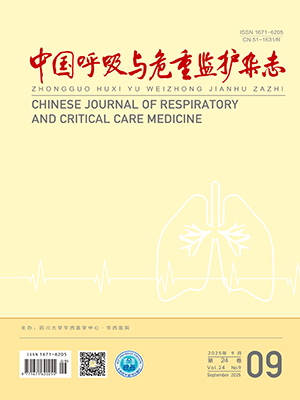| 1. |
Devaney J, Contreras M, Laffey J G. Clinical review: gene-based therapies for ALI/ARDS: where are we now?. Crit Care, 2011, 15(3): 224.
|
| 2. |
Rubenfeld G D, Caldwell E, Peabody E, et al. Incidence and outcomes of acute lung injury. N Engl J Med, 2005, 353(16): 1685-1693.
|
| 3. |
急性肺损伤/急性呼吸窘迫综合征诊断与治疗指南(2006). 中华内科杂志, 2007, 46(5): 430-435.
|
| 4. |
Ma A, Feng Z, Li Y, et al. Ferroptosis-related signature and immune infiltration characterization in acute lung injury/acute respiratory distress syndrome. Respir Res, 2023, 24(1): 154.
|
| 5. |
Tibshirani R. The lasso method for variable selection in the Cox model. Stat Med, 1997, 16(4): 385-95.
|
| 6. |
Lin X, Li C, Zhang Y, et al. Selecting Feature Subsets Based on SVM-RFE and the Overlapping Ratio with Applications in Bioinformatics. Molecules, 2017, 23(1): 52.
|
| 7. |
Ritchie M E, Phipson B, Wu D, et al. limma powers differential expression analyses for RNA-sequencing and microarray studies. Nucleic Acids Res, 2015, 43(7): e47.
|
| 8. |
Yu G, Wang LG, Han Y, et al. clusterProfiler: an R package for comparing biological themes among gene clusters. OMICS, 2012, 16(5): 284-287.
|
| 9. |
Chen Z, Huang A, Sun J, et al. Inference of immune cell composition on the expression profiles of mouse tissue. Sci Rep, 2017, 7: 40508.
|
| 10. |
Meyer NJ, Gattinoni L, Calfee CS. Acute respiratory distress syndrome. Lancet, 2021, 398(10300): 622-637.
|
| 11. |
Thompson BT, Chambers RC, Liu KD. Acute respiratory distress syndrome. N Engl J Med, 2017, 377(19): 1904-1905.
|
| 12. |
Abeel T, Helleputte T, Van De Peer Y, et al. Robust biomarker identification for cancer diagnosis with ensemble feature selection methods. Bioinformatics, 2010, 26(3): 392-398.
|
| 13. |
Chen D, Liu J, Zang L, et al. Integrated machine learning and bioinformatic analyses constructed a novel stemness-related classifier to predict prognosis and immunotherapy responses for hepatocellular carcinoma patients. Int J Biol Sci, 2022, 18(1): 360-373.
|
| 14. |
兰垚, 陈浏阳, 宋文慧. 椎间盘退变伴氧化应激关键生物标志物: 生物信息学和机器学习算法的识别. 中国组织工程研究, 2024, 28(35): 5591-5596.
|
| 15. |
侯甜甜, 董斐雅, 董佳琪, 等. 基于生物信息学和机器学习筛选类风湿关节炎关键基因. 内蒙古大学学报(自然科学版), 2024, 55(1): 38-45.
|
| 16. |
Yang C, Delcher C, Shenkman E, et al. Machine learning approaches for predicting high cost high need patient expenditures in health care. Biomed Eng Online, 2018, 17(Suppl 1): 131.
|
| 17. |
Mundra PA, Rajapakse JC. Gene and sample selection using T-score with sample selection. J Biomed Inform, 2016, 59: 31-41.
|
| 18. |
Ahmed KM, Veeramachaneni R, Deng D, et al. Glutathione peroxidase 2 is a metabolic driver of the tumor immune microenvironment and immune checkpoint inhibitor response. J Immunother Cancer, 2022, 10(8): e004752.
|
| 19. |
Tian Q, Zhou Y, Zhu L, et al. Development and validation of a ferroptosis-related gene signature for overall survival prediction in lung adenocarcinoma. Front Cell Dev Biol, 2021, 9: 684259.
|
| 20. |
Liu J, Kang R, Tang D. Signaling pathways and defense mechanisms of ferroptosis. FEBS J, 2022, 289(22): 7038-7050.
|
| 21. |
Qu M, Zhang H, Chen Z, et al. The Role of ferroptosis in acute respiratory distress syndrome. Front Med (Lausanne), 2021, 8: 651552.
|
| 22. |
Sun Y, Chen P, Zhai B, et al. The emerging role of ferroptosis in inflammation. Biomed Pharmacother, 2020, 127: 110108.
|
| 23. |
Dediego ML, Nogales A, Martinez-Sobrido L, et al. Interferon-induced protein 44 interacts with cellular FK506-binding protein 5, negatively regulates host antiviral responses, and supports virus replication. mBio, 2019, 10(4): e01839-19.
|
| 24. |
Zheng Q, Wang D, Lin R, et al. IFI44 is an immune evasion biomarker for SARS-CoV-2 and Staphylococcus aureus infection in patients with RA. Front Immunol, 2022, 13: 1013322.
|
| 25. |
Ivashkiv LB, Donlin LT. Regulation of type I interferon responses. Nat Rev Immunol, 2014, 14(1): 36-49.
|
| 26. |
Snell LM, Mcgaha TL, Brooks D G. Type I interferon in chronic virus infection and cancer. Trends Immunol, 2017, 38(8): 542-557.
|
| 27. |
Huang X, Xiu H, Zhang S, et al. The role of macrophages in the pathogenesis of ALI/ARDS. Mediators Inflamm, 2018, 2018: 1264913.
|
| 28. |
Liu S, Su X, Pan P, et al. Neutrophil extracellular traps are indirectly triggered by lipopolysaccharide and contribute to acute lung injury. Sci Rep, 2016, 6: 37252.
|
| 29. |
Scozzi D, Liao F, Krupnick AS, et al. The role of neutrophil extracellular traps in acute lung injury. Front Immunol, 2022, 13: 953195.
|
| 30. |
Tan W, Zhang C, Liu J, et al. Regulatory T-cells promote pulmonary repair by modulating T helper cell immune responses in lipopolysaccharide-induced acute respiratory distress syndrome. Immunology, 2019, 157(2): 151-162.
|
| 31. |
Sakaguchi R, Chikuma S, Shichita T, et al. Innate-like function of memory Th17 cells for enhancing endotoxin-induced acute lung inflammation through IL-22. Int Immunol, 2016, 28(5): 233-243.
|
| 32. |
Butt Y, Kurdowska A, Allen TC. Acute lung injury: a clinical and molecular review. Arch Pathol Lab Med, 2016, 140(4): 345-350.
|
| 33. |
Luh SP, Chiang CH. Acute lung injury/acute respiratory distress syndrome (ALI/ARDS): the mechanism, present strategies and future perspectives of therapies. J Zhejiang Univ Sci B, 2007, 8(1): 60-69.
|
| 34. |
Zhu W, Zhang Y, Wang Y. Immunotherapy strategies and prospects for acute lung injury: focus on immune cells and cytokines. Front Pharmacol, 2022, 13: 1103309.
|
| 35. |
Jiang Z, Zhou Q, Gu C, et al. Depletion of circulating monocytes suppresses IL-17 and HMGB1 expression in mice with LPS-induced acute lung injury. Am J Physiol Lung Cell Mol Physiol, 2017, 312(2): L231-L242.
|




